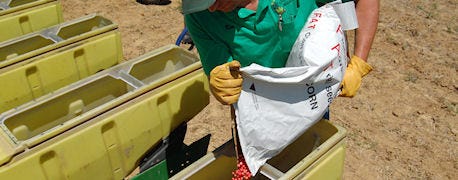February 3, 2014

A preliminary Corn Dust Research Consortium report released last week by the Pollinator Partnership offered hopeful signs that honey bee and native bee exposure to dust coming from corn planter fan exhaust could be reduced. The concerns center on pollinator exposure to dust emissions from neonicotinoid-treated seed corn.

WHAT GOES HERE SHOULD STAY HERE: When planting insecticide-treated seed corn, consider using planter box lubricants with dust-control properties, not talc or graphite.
Three research teams involved were led by Reed Johnson of Ohio State University, Mary Harris of Iowa State University, and Art Schaafsma, University of Guelph (Ontario). The teams included representatives from the American Seed Trade Association, American Honey Producers Association, American Beekeeping Federation, Association of Equipment Manufacturers, Bayer CropScience, Canadian Honey Council, Farm Equipment Manufacturers Association, National Corn Growers Association, Pollinator Partnership, Syngenta, and University of Maryland.
Key findings emerged
Honey bees can be active in and around cornfields during planting season, depending on what's flowering where. Bees collected pollen largely from trees and woody plants (apple, crab apple, hawthorn, willow, maple, and locust) during corn planting. Highest neonicotinoid residue levels in bee-collected pollen occurred during the approximately two-week planting period.
Related: Rebuilding The Bee Population
When the new BFA lubricant developed by Bayer CropScience was used in pneumatic (air) planters instead of talc or graphite, total dust and pesticide load in the dust were reduced. The report indicated that further research is needed to determine overall effectiveness of Bayer's lubricant in reducing dust and dust-borne pesticide levels.
~~~PAGE_BREAK_HERE~~~
No simple, "silver bullet" solution arose. But here are some practical solutions arose for farmers to consider:
•Use drift-reducing lubricants during planting to reduce dust.
•Follow all precautions to reduce dust and drift, especially with respect to wind and weather conditions during planting.
•Be aware that during planting season, honey bees forage primarily on pollen of woody shrubs and trees within foraging range. These woody pollen sources are particularly vulnerable to pesticide dust drift of within 175 feet.
•Control herbaceous flowers (weeds) blooming in fields to be planted with corn. While pesticide residues are detectable on such plants (predominantly dandelions) within seeded fields, honey bees don't forage as heavily on these plants as on trees and shrubs.
Related: Rebuilding The Bee Population
•Minimize unnecessary use of seed treatment insecticides and follow Integrated Pest Management guidelines.
•Communicate with beekeepers to ensure they're aware of planting timing and can take appropriate precautions to protect their colonies.
Now that the first year is completed, the CDRC will seek to replicate and test results and provisional recommendations," notes David Inouye, a University of Maryland biologist and chair of the North American Pollinator Protection Campaign. "Additional studies are needed and will lead to better understanding of impacts and actions."
The full report can be found here. Recommendations to farmers and beekeepers begin on page 23.
You May Also Like




